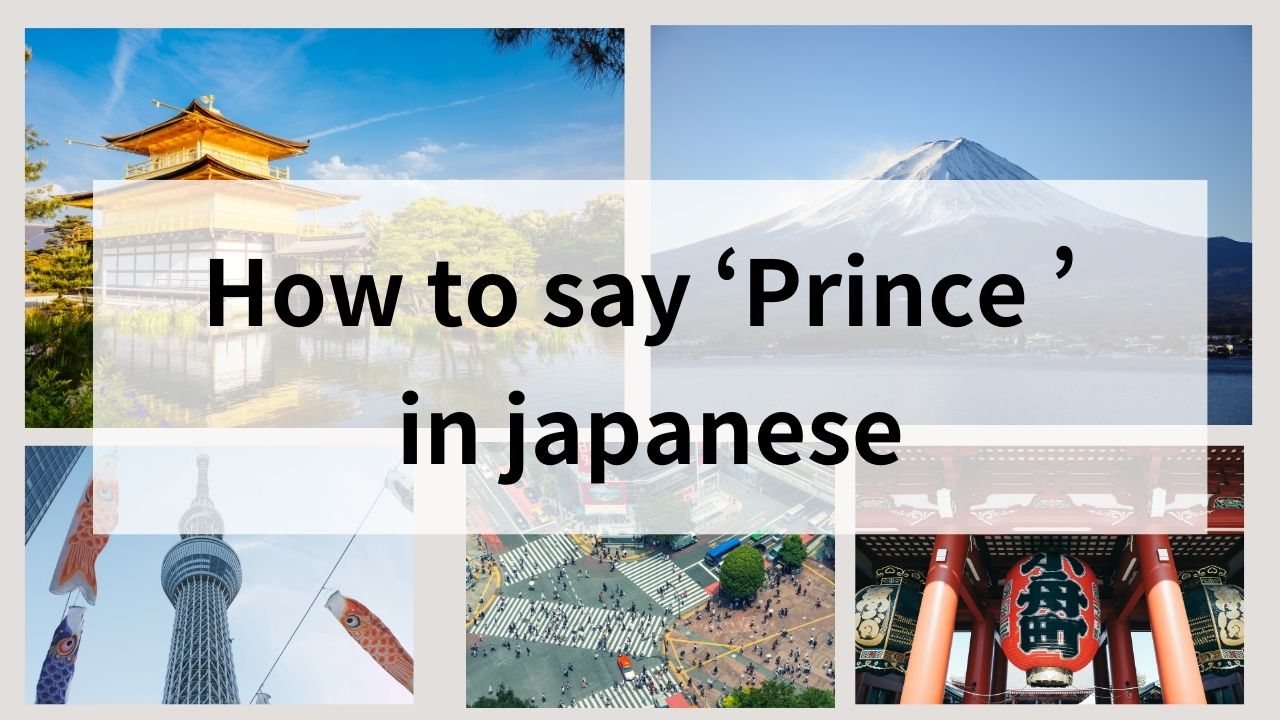Are you curious about how to say “prince” in Japanese? The term “prince” carries various cultural meanings and associations in Japan, from royal lineage to fictional characters. This guide will explore the Japanese word for “prince,” its cultural significance, and practical applications.
How Do You Say “Prince” in Japanese?
The Japanese word for “prince” is 王子 (ōji). This term is widely recognized and used in both casual and formal contexts. The concept of a prince is often intertwined with ideas of nobility, heroism, and sometimes romanticism in Japanese culture.
The Japanese Word for Prince: Ōji (王子)
“Ōji” is a term used to describe a prince and appears in various phrases and contexts. For example:
- 王子様 (Ōji-sama): “Prince” (a term of endearment or respect).
- 王子の物語 (Ōji no monogatari): “The story of the prince.”
- 王子のように (Ōji no yō ni): “Like a prince.”
Kanji for Prince: 王子
The kanji for prince, 王子, consists of two characters: 王 (ō), meaning “king,” and 子 (ji), meaning “child” or “son.” This visually striking combination reflects the royal lineage and nobility associated with the term. The primary reading for this kanji is おうじ (Ōji).
Examples of words containing the kanji 王子 include:
- 王子の夢 (Ōji no yume): “The prince’s dream.”
- 王子の冒険 (Ōji no bōken): “The prince’s adventure.”
- 王子と姫 (Ōji to hime): “The prince and the princess.”
This kanji is commonly associated with characters and stories that revolve around themes of royalty, adventure, and romance. Recognizing these patterns can help learners understand the nuanced use of 王子 in Japanese.
Does “Prince” Work in Japanese?
The English word “prince” is generally understood in Japan, particularly among those familiar with Western media or modern culture. However, its recognition might not be as universal among older individuals or in more traditional contexts. A 5-point scale rates its comprehension as:
- Rating: 3 – Generally understood (40-60% of people)
If clarity is crucial, using the Japanese term 王子 (Ōji) or 王子様 (Ōji-sama) is recommended. While “prince” may be understood in certain contexts, “ōji” ensures effective communication.
The Cultural Significance of Princes in Japan
The concept of a prince holds a special place in Japanese culture, symbolizing nobility, bravery, and often romantic ideals. Princes are often depicted in literature, folklore, and modern media as heroic figures who embark on quests for love or honor.
Princes in Japanese Folklore and Mythology
In various Japanese myths and stories, princes often symbolize the ideal hero or romantic lead. They are frequently portrayed as brave and noble characters who face challenges to protect their loved ones or their kingdom.
In modern Japanese pop culture, princes appear in anime and games, reinforcing the romantic and adventurous aspects of their character. This connection highlights the enduring appeal of prince figures across generations.
- Final Fantasy: The character Noctis Lucis Caelum is often referred to as a prince and must navigate political intrigue and personal challenges.
- Inuyasha: The character Sesshomaru is often depicted with princely attributes, showcasing nobility and strength.
- Shoujo Manga: Many shoujo manga feature prince characters who embody romance and adventure, appealing to a young female audience.
These examples illustrate how the figure of the prince continues to represent nobility, bravery, and romance, bridging traditional folklore and modern storytelling.
Differences Between Princes in Japan and Overseas
Yes, there can be subtle differences in how “prince” is perceived in Japan versus Western cultures. In Japan, a prince (王子, ōji) may often be viewed through a lens of idealism, emphasizing honor and romanticism. In contrast, Western portrayals of princes may include more diverse personalities and story arcs, often emphasizing personal growth and complexity. Understanding these cultural nuances can help avoid confusion, especially when discussing character archetypes in literature or media.
Practical Applications of “Prince” in Japanese
Learning how “prince” is used in Japanese can help you navigate conversations, understand idioms, and recognize its presence in Japanese culture.
Talking About Princes in Daily Conversation
Here are some examples of how “ōji” is used in everyday conversation:
- 王子が好きです (Ōji ga suki desu): “I like princes.”
- 王子様のように (Ōji-sama no yō ni): “Like a prince.”
Prince-Related Idioms or Expressions
While there are relatively few specific idioms involving “ōji,” the concept is often associated with nobility, adventure, and romance in Japanese culture. Here are some idioms, phrases, and expressions that incorporate or symbolize the idea of a prince:
- 王子のような人 (Ōji no yō na hito): “A person like a prince,” referring to someone who is noble and honorable.
- 王子の冒険 (Ōji no bōken): “The adventure of the prince,” commonly used to describe a heroic journey.
- 王子様の夢 (Ōji-sama no yume): “The dream of a prince,” symbolizing idealized aspirations.
These idioms and expressions reflect the deep cultural appreciation for the archetype of a prince in Japan, often tied to themes of bravery, nobility, and romance. By learning these phrases, you can gain a deeper understanding of how princes are interwoven with Japanese language and values.
Princes in Japanese Media and Products
Princes are also prominently featured in Japanese media, showcasing their appeal and cultural significance. Here are some notable examples:
- Anime and Manga: Many series feature prince characters who embark on adventures, often appealing to themes of love and heroism.
- Video Games: Games like “Final Fantasy” and “Kingdom Hearts” often include prince characters who play crucial roles in their narratives.
- Merchandise: Products featuring prince characters, such as figurines or clothing, are popular among fans of anime and manga.
These examples highlight how the figure of the prince is not only a character archetype but also a cultural symbol in modern Japanese media, reflecting ideals of nobility and adventure.
FAQs
Here are some frequently asked questions about princes in Japanese culture and language.
Is the Concept of a Prince Popular in Japan?
Yes, the concept of a prince is popular in Japan, often associated with nobility and adventure. It is frequently portrayed in literature, anime, and games.
How Do You Write “Prince” in Japanese?
The word “prince” can be written in different scripts in Japanese: hiragana and kanji. Each script serves different purposes depending on the context and formality. Here’s a breakdown:
- Hiragana (おうじ, Ōji):
Hiragana is the most commonly used script for “prince” in casual writing or when teaching children. It is simple and easy to read, making it ideal for everyday use. - Kanji (王子, Ōji):
Kanji is the most formal and traditional way to write “prince.” It is often used in literature, official documents, and cultural contexts. The kanji itself conveys a sense of nobility and sophistication.
Choosing which script to use depends on the tone, audience, and purpose of your communication. Understanding these variations can enhance both your written and spoken Japanese skills.
Conclusion
The concept of a prince, or “ōji” in Japanese, is more than just a character type—it symbolizes nobility, bravery, and cultural significance. By understanding its role in Japanese language and traditions, you can deepen your appreciation for this archetype and its place in Japanese society.








